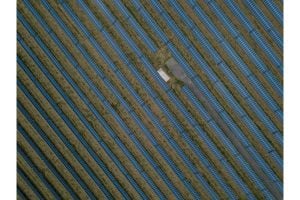
Johns Hopkins scientists have enhanced plastic materials used with devices like wind turbines and solar panels by adding a small molecule to their composition. Their results, described in the Journal of Applied Physics, could lead to better energy storage in these renewable energy systems.
“Traditional semiconductor switches are made out of silicon, but we found that polymer-based switches can store electricity more effectively,” said study co-author Howard Katz, professor of materials science and engineering at the Whiting School of Engineering. “Our key innovation was adding a specific molecule that resembles the original polymer, but is much smaller and purer. Think of it like adding a more specific ingredient to a recipe—one small refinement changes how the whole material behaves electronically.”
The team’s approach was based on previous observations, according to co-author Chen Chi, a doctoral candidate in materials science.
“In this project, we wanted to improve these devices by adjusting their form. We saw that separate transistors with the polymer and the polymer molecule worked well and theorized that combining the polymer with the molecule would improve charge storage in the transistors,” Chi said.
Under Katz’s guidance, Chi made an individual polymer segment called BTTT and mixed it with Polymer-BTTT to test this theory. Using x-ray diffraction, he found that the mixture formed clumps on the surface with a less dense crystal structure than a pure polymer.
“The mixture BTTT has a larger number of small molecules and produces more grain-like structures than the material with the long polymer chains, which is a difference that had not been reported before and suggests that the electronic properties—how electricity flows through a material—would be different with these materials,” says Katz.
To test if BTTT would retain electricity differently than Polymer-BTTT, the team repeatedly applied voltage to each mixture. They found that the BTTT mixture has an increased ability to trap electrical charges when the materials were used in transistor insulators and electrical energy storing devices, called capacitors.
“We think this reaction is due to the molecules clustering together to hold a charge,” says Chi.
The researchers will next focus on characterizing the crystal structures formed in the polymer mixture.
“We want to conduct advanced probing methods to recognize what these clumps are so we can pinpoint why this mixture holds electric voltage so well. We also plan to continue making these polymer molecule combinations in OFETs with different polymers to see which is the best at retaining energy,” says Katz.
Katz and Chi worked on this project with collaborators from the departments of Chemistry and Physics and Astronomy at the Krieger School of Arts and Sciences. This research was supported by United States Department of Energy, Office of Science and the Office of Naval Research.